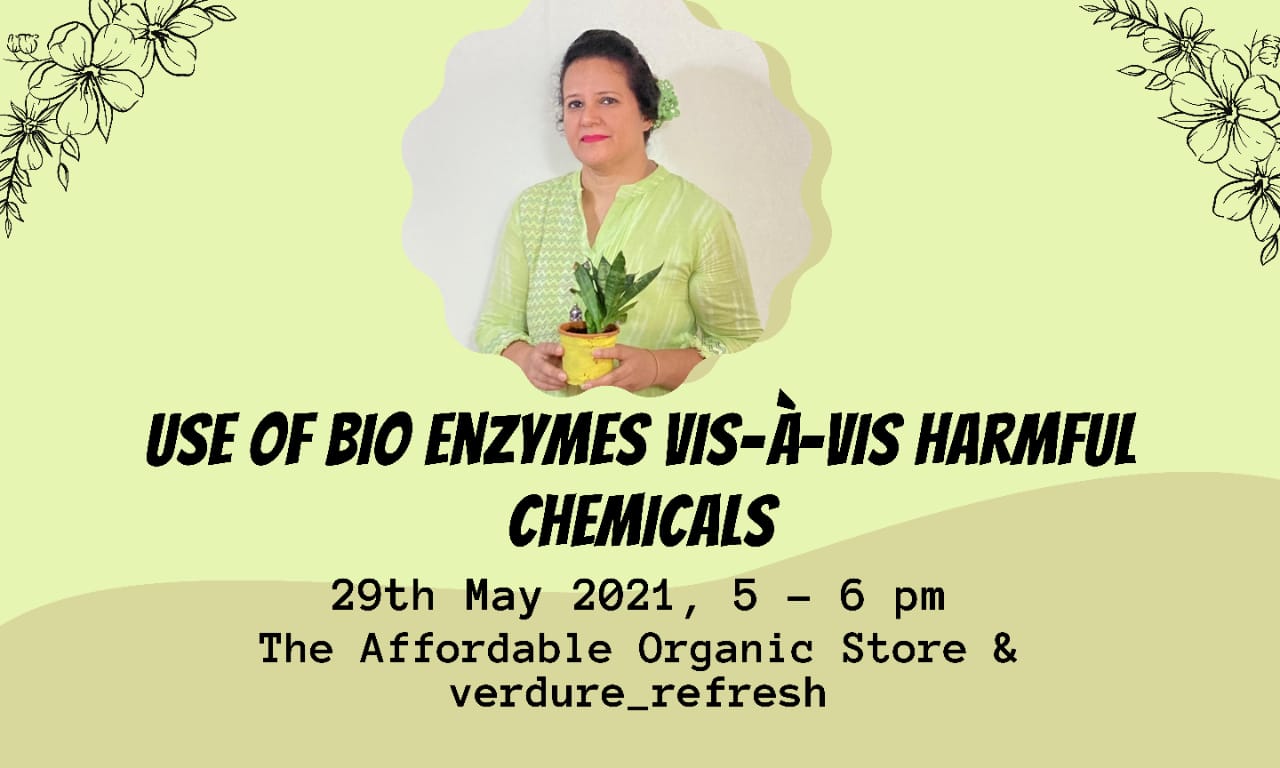Bio enzymes are the need of the hour and it’s very important to switch to a greener and safer method of gardening.
And what’s better than talking to our gardening expert Mrs. Ritu Bagga who runs a successful Instagram Page verdure_refresh and is an eco-entrepreneur. She is here to make us aware and teach us the Use of Bio Enzyme vis-à-vis harmful chemicals.
Topics Covered:
- What is bio enzyme & why
should we use it? - How to make Bio enzymes at home?
- What hazards do we face by using chemicals?
- Use of Bio enzymes
- Tips and tricks
Ritu’s say on Bio-enzymes:
“Hello, all. Welcome to another workshop by TAOS. Today we have Miss Ritu with us who’ll talk about the necessity of using bio-enzymes and how we can produce them. Let’s start,” said Jitender.
“Hello, everyone. I am Ritu, and today we will go through a presentation on bio-enzymes. I am an eco-entrepreneur and an urban gardener. I think that to have a green farm, you should look forward to organic gardening, sustainability, and waste management.
To start with, let’s discuss what is bio-enzyme. This is a simple fermentation process that creates a natural chain of proteins and enzymes. It is a by-product of good bacteria or yeast and is composed of complex proteins and salts. Now, bacteria are part of our body, particularly the good ones. However, they get removed from our bodies, our clothes, and even soil by the use of chemicals. These chemicals that are destroying the good bacteria are basically creating a disbalance in nature. The hazards present in the increasing use of chemicals in our life is resulting in various changes in nature, as well as in our own individual lives. Even things like toothpaste, bathroom cleaners, detergents, etc., are all composed of strong chemicals which are having a harmful impact on us. If you want to switch to an alternative good way, only organic products are the solution.
Now, cleaners we buy include phosphates, ammonia nitrate, chlorine, and various harmful substances that pollute the environment. It also causes breathing problems and skin irritation. Bio enzymes are the most perfectly natural way for home cleaning needs. There is an urgent need to switch to organic and healthier lives. If every household starts to use bio-enzymes instead of chemical-studded products, our water bodies which are currently filled with household chemical waste will be regenerated and cleaned in no time. We can see evidence of the river Ganga turning green in Varanasi due to the growth of algae in the water. Hence, the urgency.
Coming to how we can make bio-enzymes, we just need four items: A plastic container, water, orange peels, or citrus peels, and Jaggery in the ratio 15:10:3:1. You need to take a plastic jar, about a 1.5-liter jar, and add 1 liter of water in it. Then, add some banana peels, or lemon peels, any citrus fruit would do. Then add 100 grams of jaggery. Wide-mouthed containers would have fewer gasses being produced. It takes about three months for the bio-enzyme to form. In the first month, you have to open the container and close it again every day, to release the gases that are being formed in it. Also, you need to store it in a cool place.”
We also need to know the purpose of why we are making this since the composition would vary accordingly. This composition I have stated above is going to act as a very good fertilizer for the soil. Even the prepared bio-enzyme will produce gases for about a month, and the pH level is around 2.4 to 4.5 where no microorganisms can survive. So, that was about producing the bio-enzymes. Whenever the bio-enzyme is ready, there will be three different layers of it. The bottom layer, is whitish and the second water would be a bit mushy in nature, the third one can be ground and used on tough surfaces. You can add more jaggery if there are maggots on it. Very rarely we find a red or blue layer, just discard that. If there is any foul smell also, discard it.”
“What is its shelf life once it is produced?”
“Since this is a naturally made product, there is no shelf life. The older it is, the better it is.”
“For making Shampoo, we need to take 50ml bio-enzyme and soaked nuts water. Soak them for 10 days and it is ready. For detergent, we use 50ml of clear enzyme and 100ml of rock salt, and soap nuts can be used. For fertilizers, we use a 1:10 ratio, etc. It depends to some extent on the plant though,” said Ritu.
“How can we use bio-enzymes for cleaning purposes?”
“Use 30-50ml of bio enzyme in a bucket of water, and it would serve the same purpose as phenyl.”
“Do you sell bio-enzymes?”
“Yes, they can reach out to me for that.”
“If we’re using bio-enzymes on our body, will there be any smell?”
“The same of the citrus fruit that you use. There won’t be any foul smell.”
“What else can we use instead of citrus?”
“I have a rose one, which can be used as a room freshener. The citrus one is used for cleaning purposes. I have also made a neem one as well. Nowadays people mostly are using citrus peels only for the purpose, but we can experiment with other things. For example, I’m making a bio-enzyme of marigold which can be used as a room freshener.”
“That was a great session. Thank you for joining us today.”

